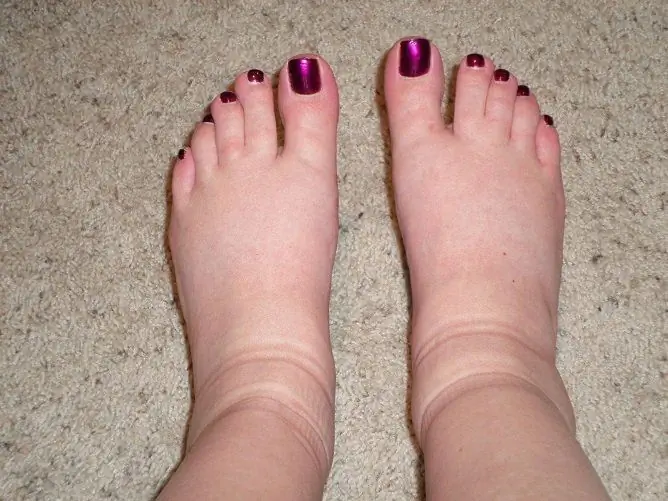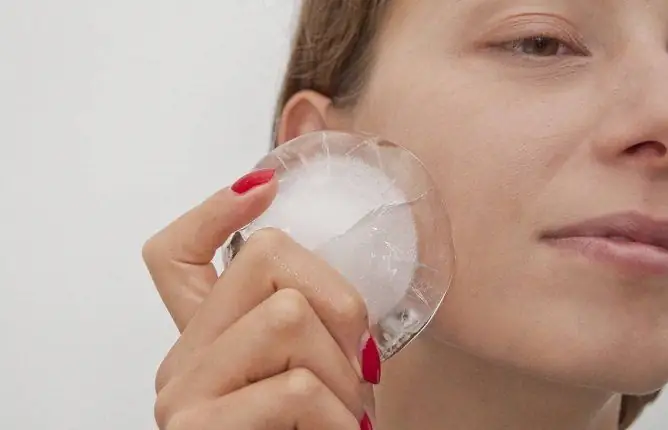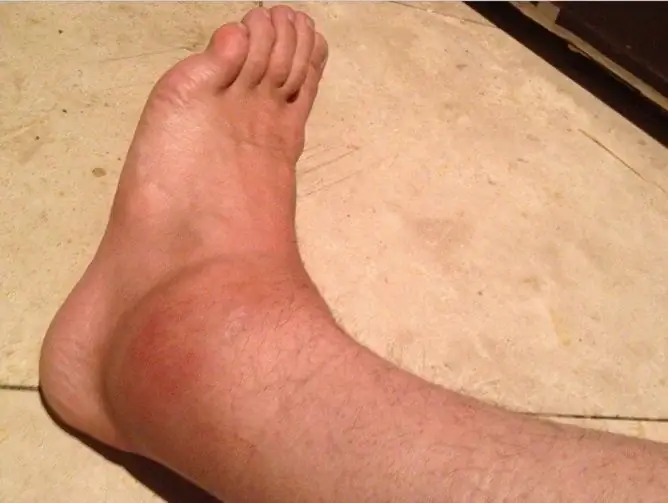- Author Rachel Wainwright [email protected].
- Public 2024-01-15 19:51.
- Last modified 2025-11-02 20:14.
How to quickly relieve leg swelling at home
The content of the article:
-
How to remove leg swelling: home methods
- Nutrition correction
- Folk remedies
- Foot baths
- Drug treatment
- Swelling of the legs: symptoms and common causes
- Video
How to quickly relieve leg swelling at home? Swelling of the legs can occur for various reasons, ranging from fatigue after prolonged physical activity, to heart disease. There are several effective ways to eliminate them - nutritional correction, exercise, foot baths, compresses, medicinal plants. You can temporarily eliminate the swelling at home, but further treatment should be prescribed by a doctor.

You can relieve leg swelling at home, but in case of diseases it is only a temporary measure.
How to remove leg swelling: home methods
Puffiness is an unpleasant symptom that is often accompanied by a feeling of heaviness in the lower extremities. You can remove leg swelling at home, if the cause is not a serious illness. In this case, it is effective to use foot baths and ointments, foot massage, exercise.
Nutrition correction
The easiest way to relieve puffiness is to correct the diet. It is necessary to exclude the use of salt, as it retains fluid in the body. This applies not only to pure salt, but also to products with a high content of it - preservation, salted fish, smoked products, sausages, chips. In addition, you need to limit the use of other foods that can retain fluid:
- dairy products (especially milk, cottage cheese, hard cheeses);
- nuts;
- red meat.
It is also recommended to limit the use of coffee, quit smoking and alcoholic beverages. It is beneficial to include more fiber in your diet - fresh fruits and vegetables.
Folk remedies
Folk recipes also help to quickly drive away puffiness. At home, you can use medicinal herbs that have a diuretic effect. These include:
- parsley;
- nettle;
- rosehip;
- horsetail;
- yarrow.
A decoction must be prepared from medicinal plants. To do this, you will need 1 tablespoon of leaves or plant fruits, as well as 1 glass of boiling water. Plants must be filled with water and boiled for 3-5 minutes. You need to take such a decoction 3 times a day.
Due to the diuretic effect of decoctions, when they are taken, excess fluid will be excreted in the urine.
Foot baths
If the cause of the swelling is fatigue and increased stress on the legs, you can eliminate the symptom with foot baths. You can carry out the procedure at home. For this, the following medicinal plants are used:
- chamomile;
- sage;
- succession;
- horsetail.
From herbs, you need to prepare an infusion at the rate of 100 g of flowers or leaves per 1 liter of water. Dry plants are filled with boiling water and infused for 40-60 minutes. After that, the infusion is added to a container with water (about 3 liters). The legs are placed in a container for 20 minutes. Foot baths increase blood circulation in the legs and help reduce swelling. After the bath, it is recommended to take a contrast shower for the feet or wipe them with an ice cube.
Drug treatment
Drug therapy is selected taking into account the cause of the development of puffiness.
The use of diuretics (diuretics) may be required. Diuretics are symptomatic because they can only eliminate the symptom. It is impossible to get rid of the disease with the help of diuretics. The following drugs are used:
- Loop diuretics - Furosemide, Torasemide. Strong-acting drugs that can increase urine output up to 3 times. They are used to quickly relieve puffiness.
- Thiazides and thiazide-like diuretics - Hypothiazide. Also used for short-term treatment.
- Potassium-sparing diuretics - Spironolactone. Used for long-term treatment, can be used with other diuretics. Their advantage is that, unlike other diuretics, they do not excrete potassium.
It is not recommended to use diuretics on your own, without a doctor's prescription. If the cause of edema is prolonged sedentary or standing work, walking in heels, then medications are not indicated. If the reason is more serious - only diuretics will not help, it is necessary to treat the underlying disease.

Spironolactone is a potassium-sparing diuretic used in the complex therapy of diseases that cause swelling
Swelling of the legs: symptoms and common causes
Puffiness occurs due to the accumulation of fluid in the intercellular space. Different parts of the lower extremities may swell:
- foot;
- ankle;
- shin;
- hip.
Most often, the legs swell in the ankle area. In women, this problem often arises from walking in uncomfortable high-heeled shoes. Eating a lot of salt, dairy products, or insufficient exercise may be the cause.
The occurrence of edema on the legs may indicate the following problems in the human body:
| Disease | Explanation |
| Heart failure |
Swelling can be one of the symptoms of heart disease. In this case, the heart cannot contract enough to push all the blood into the vessels. In this regard, the blood stagnates, which causes swelling. With heart failure, the swelling increases in the evening, and decreases in the morning. There may be other symptoms of the disease: shortness of breath, cough, heart pain. |
| Vein thrombosis of the lower extremities | With thrombosis, the legs swell due to a violation of the outflow of blood below the site of the thrombus. Symptoms begin abruptly over a period of several hours. |
| Lymphatic drainage disorder | Extremities can also swell due to a violation of the outflow of lymph through the lymphatic vessels. The cause of lymphostasis can be overweight, a sedentary lifestyle, tumors and trauma to the organs of the lymphatic system. |
| Kidney pathology | With kidney pathology, swelling of the legs develops due to increased excretion of proteins in the urine. Most often, edema is a symptom of acute glomerulonephritis, nephrotic syndrome, renal failure. |
When puffiness occurs, you need to pay attention not only to localization, but also to other signs:
- Time of occurrence. In the morning, swelling worsens with kidney disease, in the evening - with high stress and fatigue, heart disease.
- Duration. With pathology of the kidneys or heart, the symptom exists for a long time - several months. With thrombosis, edema occurs within 2-3 days.
- Consistency - density or looseness. Dense edema is characteristic of heart failure, thrombosis and thrombophlebitis, impaired lymph outflow, loose - for renal failure and overload of the limbs.
- Soreness to pressure. It is characteristic only for deep vein thrombosis.
If the swelling does not go away for several days, there are other symptoms (pain, shortness of breath, pallor or blue skin) - you must definitely consult a doctor for diagnosis and prescription of specific treatment. Home treatment may not be enough.
Video
We offer for viewing a video on the topic of the article.

Anna Kozlova Medical journalist About the author
Education: Rostov State Medical University, specialty "General Medicine".
Found a mistake in the text? Select it and press Ctrl + Enter.






